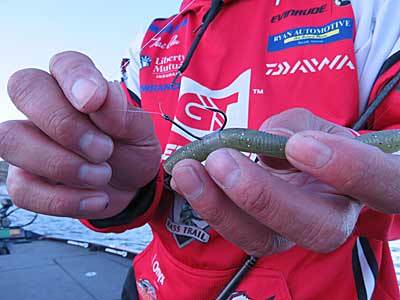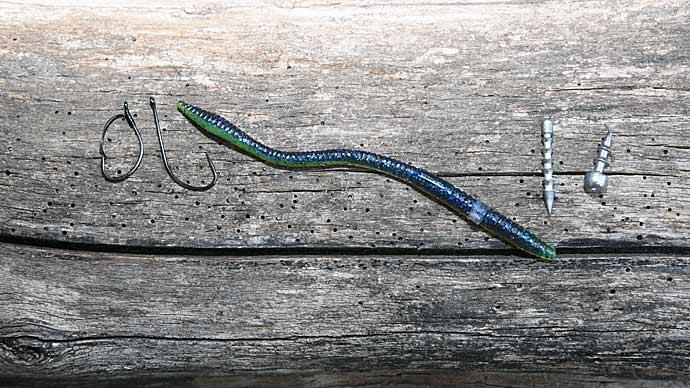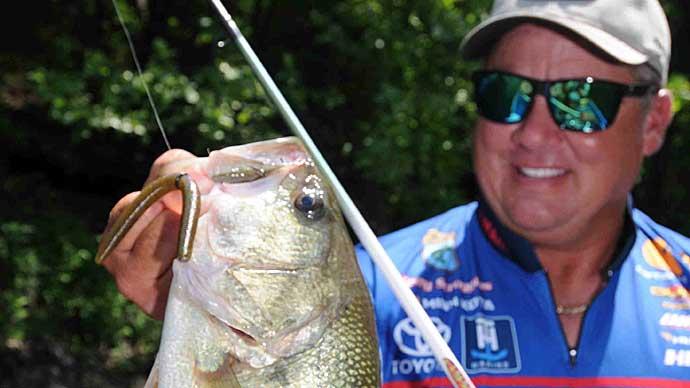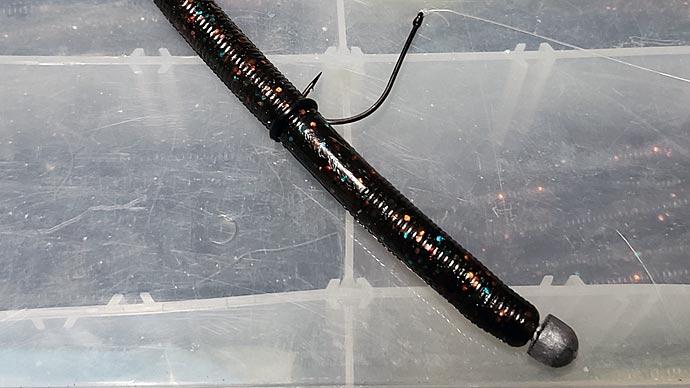
Yamamoto pro Tai Au has had 17 top 10 finishes in the past eight years from California to the East Coast, and he claims that the Neko rig has been the most vital rig for him in all those tournaments. We talked to him while he was at the Harris Chain in Florida pre-fishing for the MFL Pro Circuit. He’s had twenty-one consecutive limits on tour at this point. Not bad for an Arizona boy!
Tai learned about the Neko from some of his northern California buddies seven or eight years ago, after they got the technique from Japanese anglers. Since then, he's refined the technique to his liking. "The biggest mistake I see people making with this rig is fishing too slow," Tai says. "They drag it too much," he explains, "and then it's more likely to snap, which is a big pain. You break the line and take the efficiency out of the lure."
Rigging The Neko
Tai generally starts with a 5-inch Green Pumpkin (301) Yamamoto Senko. If the water is dirty, he'll choose a darker color like black and blue, and if the sun is bright and the water is clear, he'll use a Baby Bass (305) or Natural Shad (306). Sometimes he uses a 6-inch Senko or a 5.75” Kut Tail worm.
Tai uses G7 Tubing bands from Tackle Warehouse. The 5-inch Senko takes a 7mm tube, and the 6-inch Senko takes an 8mm tube. The bands come in black, clear, red, and watermelon green. Tai uses clear. They make it very easy to switch baits – pull the old bait apart to remove it, then use the pliers to put in a new one.

Another thing he does, which is crucial, is to add a 3/32-ounce tungsten nail weight, either Eco Pro or Voss. You can get the 3/32-ounce Eco Pro Tungsten Nail'em Weights at Tackle Warehouse. You can find the stepped Voss nail weights at vossweights.com.
The addition of the slightly heavy nail weight makes it possible for Tai to fish his Neko rigs all year long, not just when the bass are shallow. He uses special O-ring pliers to slip the G7 tube onto the bait just above the egg sack, then inserts the nail sinker in the head. "Get it in as straight as you can in one shot," he says, "if you have to take it out and try a second time, it'll fall out when you're fishing." A Decoy Big Bite Finesse Worm20 hook completes the bait.
The point of the hook must aim toward the tail of the Senko. That way, if you do hit something, the line works as a weed guard. On the other hand, if the hook faces the front, it'll snag on everything. Also, he slips the hook under the tubing, not into the bait, making the soft Yamamoto baits last a long time. Finally, he doesn't add any scent because the baits are so salty that he doesn't need it.
Tai uses a spinning rod for the Neko because the lure needs to free fall. His favorite Neko rig rod is his 7'3" medium-heavy Fitzgerald Stunner rod with 12-pound braid and an 8- to 10-foot 8-pound-test Sniper fluorocarbon leader.
Technique
Tai likes to cover water, but he slows it down a bit before the sun is up. He says that the fish aren't super active that early, and the most productive lure is something that will stay in the strike zone. So Tai tends to focus on secondary points early – ambush zones.
He starts with the Neko rig by throwing the lure and shaking the rod tip while holding it at about 10 or 11 o'clock as it falls. Just shaking the rod, so the tip moves only a few inches, but steadily. He reels it in once it hits bottom and throws it to the next spot.
In 2021 Tai won a tournament at Havasu fishing the Neko in just one or two feet of water. In the clear water of Havasu, he fishes fast – in fact, the clearer the water, the faster the fishes. Tai casts out in front of the boat. If you drag it, you'll snag it, so he picks a spot, casts to it, and lets the bait fall.

"I pick a spot – a ledge, in front of a tree, a rock, whatever – and I let them see it. That nail weight makes the lure dart down, zigging and zagging, looking like something darting around looking for food." The clearer the water, the better it works. He won't fish the Neko in muddy water.
The nail in the head helps it fall faster and lets Tai cover water while still basically finesse fishing – but vertically and fast, like a reaction bait. It’s the best of both worlds. The clearer the water, the faster you can go because the fish can see it from farther away. He also uses the Neko to catch fish that he sees below the boat on his graph.
He's caught fish on this rig in a foot of water, and he once caught a big fish at 55 feet that he had spotted on the graph. He’s also used it to target suspended fish in the middle of the lake. Just don’t make the mistake of fishing it slowly, he says. Instead, throw it out and let it twirl down. Most of the bites will come within 5 seconds after hitting the bottom. He'll shake it on the way down, leave it still on the bottom for a second, then shake it once and lift it. He'll reel in and re-cast if there's no weight on it.
Tai says you can feel the Senko or worm wiggle, and when you get a bite, it feels different when you shake it – just solid. When that happens, he reels until he feels a bit of pressure, then gives it a little tug and reels it in – like a drop-shot set. You'll often shake it and not know if there's a fish on it or not, he says. In that case, hold the rod still at 11:00 and watch it. If it loads up, give it that little tug and reel.
"This is an easy bait to fish," Tai says. "People overthink it. Once it's on the bottom, don't move it more than a foot or two. Just pick your targets." He also fishes a Neko when covering water, looking for active fish. If the water is stained, he'll target cover more frequently – logs, brush piles, weeds, and more.
You can cover a flat in clear water, and when that Senko starts falling, they'll chase over and eat it before it hits bottom. It's all down to the vibration and sight of the lure, and the heavier the weight, the more bites he gets. He used to carry a lot of different weights until he realized that he could fish the 3/32-ounce weight everywhere.
It is also one of his go-to rigs for locating fish in practice. First, he'll cut the tips off the hooks or file them down to find the active fish. Then on the last day of practice, he'll hook a few to check out the quality.
"I can't think of a more versatile technique," Au says, "you can use from one to 55 feet and probably more, fish it vertically, fish suspended fish, skip it under stuff – there's just no end to where you can use it." He's caught fish all over the country on the Neko rig, and he says he thinks you catch the fish you'd catch on a jig without the hassle of a jig. The Neko rig is just an all-around dynamite bait.
BassResource may receive a portion of revenues if you make a purchase using a link above.




